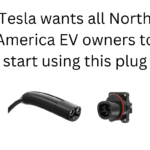That is – “Some people say hybrid vehicles such as the Prius are only a bridge to the future” – meaning that the Prius somehow leads “us” to a future vehicle market where electrified vehicles are predominant. But when he followed that by talking about a long, and sturdy, bridge, he made it clear that in Toyota’s eyes the technology that will be dominant is yet to be determined. Batteries? Fuel cells?
At the moment Toyota is working on the fourth generation Prius. He stated that in each previous generation they’d improved fuel economy by 10%, and they intend to do the same with the 4th generation. Hardly what I’d call an earthshaking goal. If they’re really intent on fuel economy they would adopt electric drive-trains in a bigger way, because they are far more fuel efficient than the Prius.
To underscore the commitment to Hybrids, he called on “the auto industry to sell 5 million of these vehicles in the United States by the end of 2016 on a cumulative basis.”
Again – focusing on Hybrids, not focusing on moving forward to better technologies.
Following that he talked about what would be at the other end of that long bridge.
Now, if hybrids are the bridge to the future, what is the other end of the bridge? Like everyone else, we are pursuing a portfolio of options. But we have made big progress in developing a hydrogen fuel cell vehicle. Toyota will be able to offer that, in a sedan, around 2015. A fuel cell vehicle has zero tail pipe emissions just like an electric vehicle. But it does not have issues of driving range and charging time that EV’s have. I personally expect a lot from this hydrogen fuel cell technology. If government and industry work together, this might be part of the long-term solution.
At the time of my previous blog post on Toyota’s plans (see link above), Toyota had put out a press release glowingly talking about the virtues of their hybrid vehicles, and describing Fuel Cells and Lithium-Sulfur batteries as the future. Here they are, again talking about Fuel Cells.
Next, he talked about some other technological challenges that Toyota is tackling …
Automated driving technologies –
We are now able to recognize driving conditions surrounding the car and to determine a driver’s physical condition. We do that by using millimeter wave radar and an object-recognition camera system. We can control vehicle behavior using sensors on the front of the vehicle to apply brakes and control steering.
Connected vehicles –
how do we allow cars to be connected to other vehicles, to roads and other infrastructure, and to the Internet as a whole? If we could combine vehicle-to-vehicle and vehicle-to-infrastructure communication, we would create an Intelligent Transportation System. That could detect congestion far in advance. We could see a vehicle even before it enters a highway. Or we could see a vehicle hidden behind a fence or a building.
Those two things do go together into what could be an interesting system. One that Big Brother wants because Big Brother wants to track our every move. That aside, automated driving could radically reduce accident rates and needless death, pain, and suffering. The connected vehicle thing, however, is an open question as to what it would be useful for. Some think that automated driving will require vehicles to communicate with each other, with the road infrastructure, etc. Others say that’s not necessary, that automated vehicles only have to use sensors to look at each other.
This also has the potential to prevent accidents and congestion. It also would reduce emissions. The question is how we get it all done and who pays for it. We will need standards that specify how cars made by different manufacturers will communicate with each other. And an overall communications network must be created. Government and industry will have to work together to allow that to happen. New business models and new industries may also have to spring up.
Full press releases: http://greentransportation.info/ev-tracker/toyota/2013-09-30-hybrids.html![]()
- Highway design could decrease death and injury risk, if “we” chose smarter designs - March 28, 2015
- GM really did trademark “range anxiety”, only later to abandon that mark - March 25, 2015
- US Government releases new regulations on hydraulic fracturing, that some call “toothless” - March 20, 2015
- Tesla Motors magic pill to solve range anxiety doesn’t quite instill range confidence - March 19, 2015
- Update on Galena IL oil train – 21 cars involved, which were the supposedly safer CP1232 design - March 7, 2015
- Another oil bomb train – why are they shipping crude oil by train? – Symptoms of fossil fuel addiction - March 6, 2015
- Chevron relinquishes fracking in Romania, as part of broader pull-out from Eastern European fracking operations - February 22, 2015
- Answer anti- electric car articles with truth and pride – truth outshines all distortions - February 19, 2015
- Apple taking big risk on developing a car? Please, Apple, don’t go there! - February 16, 2015
- Toyota, Nissan, Honda working on Japanese fuel cell infrastructure for Japanese government - February 12, 2015















